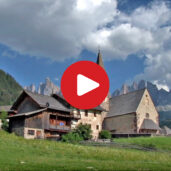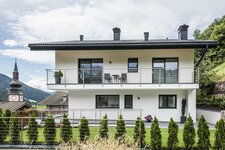The Church of St. James, an old high-altitude sanctuary, is perched on a hill along the ancient path from Funes to the Valle Isarco
Image gallery: San Giacomo al Passo
The place is known as San Giacomo al Passo (St. Jakob am Joch): The farmsteads of San Giacomo, the small hamlet in Funes, are spread out above the valley floor. On the Tschaufis ridge, finds of bones and shards of ritual vessels attest to a former sacrificial site. This was a pre-Christian place of worship, which an old connecting path later passed by. This path was important because, until a few centuries ago, the Valle Isarco valley was marshland and therefore almost impassable.
Today, the little Church of San Giacomo al Giogo, that's to say St. James on the Pass, stands here at an altitude of over 1,200 metres. Its nave walls are Romanesque, the tower is Gothic, and the winged altarpiece inside dates from 1517. The paintings are outstanding examples of the Danube School, the link between the Late Gothic and Renaissance periods in parts of Austria and Bavaria.
One of the most famous representatives of this style is Lucas Cranach the Elder. The winged altarpiece of St. James on the Pass was probably created by Ruprecht Potsch and Philipp Diemer, two other artists of this school. From San Pietro di Funes, the main village in the valley, you can reach San Giacomo on foot in half an hour: The walk partly follows the "Sunnseitnweg" trail.
The Pramstrahler, Unterweg, Drocker, Zinner, Gutshof zu Puez, and Rafreid Farms, which were first mentioned in the 12th century, still exist today. The main source of income for the small hamlet is still agriculture and dairy farming, although tourism is also becoming more important at this altitude. In Funes, this is particularly evident in sustainable, gentle tourism, and in "Slow Food Travel", a project that focuses on the relationship with the land, its people and its cuisine.



























